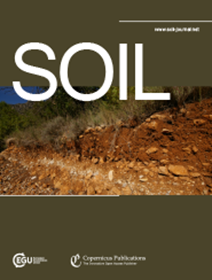循环经济的磷肥施用方法必须根据土壤特性进行调整
IF 4.3
2区 农林科学
Q1 SOIL SCIENCE
引用次数: 0
摘要
摘要。虽然有相关的知识是基于土壤性质对普通商业肥料效率的影响,但这种影响对于使用净水中的活菌石作为符合循环经济方法的创新磷肥仍然知之甚少。本研究旨在评价土壤性质对水净化回收的橄榄石作为磷肥效率的影响,并为其有效利用提供实用建议。通过盆栽小麦试验,比较了两种施磷量(50 mg和100 mg P kg-1)下的Vivianite和可溶性无机磷肥(过磷酸磷)在不同性状土壤上的差异。在土壤干物质产量、磷素吸收和奥尔森磷方面,可溶性磷肥的效果最好,而在作物收获后,有机磷在土壤中可提取铁的效果最好。在酸性土壤(pH <;6.6)。在这些酸性土壤中,根据相同数量的可溶性肥料(即P肥替代值- pfrv -以DM为基础)的施用量,vivianite对干物质(DM)产量的影响平均相当于26%或40%,在某些情况下约为50%。对土壤中奥尔森磷的影响平均相当于在酸性土壤中施用相同数量的可溶性矿物肥的49%或61%,具体取决于施用量。这可以解释为这种肥料产品在酸性条件下的溶解度增加,在这些土壤中DTPA可提取铁的增幅最大。酸性土壤是指初始奥尔森磷低于肥料响应阈值的土壤。然而,不同处理方法(DM、P吸收和Olsen P)的PFRV随着初始Olsen P和TV差异值的增加而下降(占解释方差的46%至87%),而不是随着pH值的增加而下降。这表明,除了土壤pH值,植物的低磷可利用性可以触发植物和微生物的动员机制,从而提高了vivianite作为P肥的效率。需要进一步的研究来评估橄榄石的残留效应及其在田间条件下的有效性,特别是在低磷有效状态和酸性土壤中。本文章由计算机程序翻译,如有差异,请以英文原文为准。
Circular economy approach in phosphorus fertilization based on vivianite must be tailored to soil properties
Abstract. Although there is relevant knowledge based on the effect of soil properties on the efficiency of common commercial fertilizers, this effect remains poorly understood for the use of vivianite from water purification as an innovative P fertilizer meeting a circular economy approach. This study aimed to evaluate the effect of soil properties on the efficiency of vivianite recovered from water purification as a P fertilizer and to provide practical recommendations for its effective use. Vivianite and a soluble mineral P fertilizer (superphosphate) were compared at two P application rates (50 and 100 mg P kg–1) in soils ranging widely in properties in a pot experiment using wheat. Soluble P fertilizer provided the best results in terms of dry matter (DM) yield, P uptake, and Olsen P in soils, while vivianite led to the best results of DTPA extractable Fe in soils after crop harvest. The application of vivianite as a P fertilizer was more efficient in acidic soils (pH < 6.6). The effect of vivianite on dry matter (DM) yield was equivalent on average to 26 or 40 %, depending on the rate, of the same amount of soluble fertilizer in these acidic soils (i.e., P fertilizer replacement value –PFRV– on DM basis), it being around 50 % in some cases. The effect on Olsen P in soil was equivalent, on average, to 49 or 61 %, depending on the rate, of the same amount applied as soluble mineral fertilizer in acidic soils. This can be explained by the increased solubility of this fertilizer product under acidic conditions, supported by the highest increase in DTPA extractable Fe in these soils. Acidic soils were those with initial Olsen P below the threshold value for fertilizer response (TV). However, PFRV on different approaches (DM, P uptake, and Olsen P) decreased more consistently with increased values of the difference between initial Olsen P and TV (46 to 87 % of the variance explained) than with increased pH. This reveals that besides soil pH, a low P availability to plants can trigger plant and microbial mobilization mechanisms, leading to increased efficiency of vivianite as a P fertilizer. Further studies are needed to assess the residual effect of vivianite and its effectiveness under field conditions, particularly in soils with low P availability status and an acidic pH.
求助全文
通过发布文献求助,成功后即可免费获取论文全文。
去求助
来源期刊

Soil
Agricultural and Biological Sciences-Soil Science
CiteScore
10.80
自引率
2.90%
发文量
44
审稿时长
30 weeks
期刊介绍:
SOIL is an international scientific journal dedicated to the publication and discussion of high-quality research in the field of soil system sciences.
SOIL is at the interface between the atmosphere, lithosphere, hydrosphere, and biosphere. SOIL publishes scientific research that contributes to understanding the soil system and its interaction with humans and the entire Earth system. The scope of the journal includes all topics that fall within the study of soil science as a discipline, with an emphasis on studies that integrate soil science with other sciences (hydrology, agronomy, socio-economics, health sciences, atmospheric sciences, etc.).
 求助内容:
求助内容: 应助结果提醒方式:
应助结果提醒方式:


